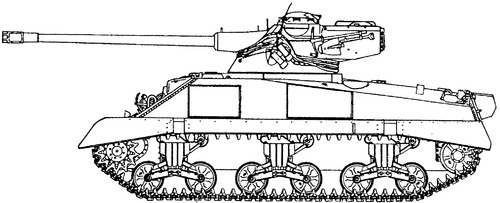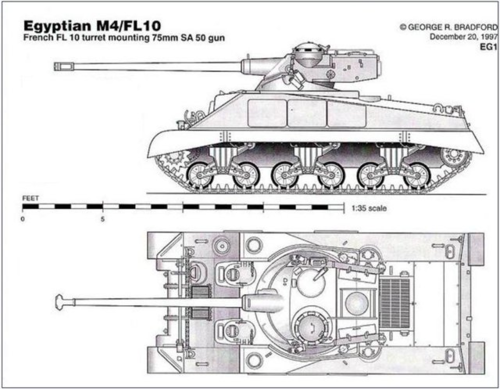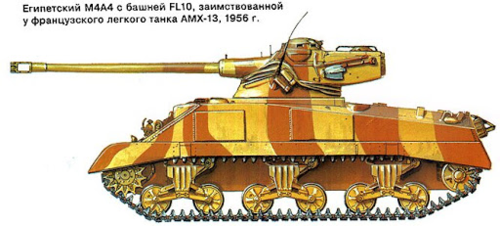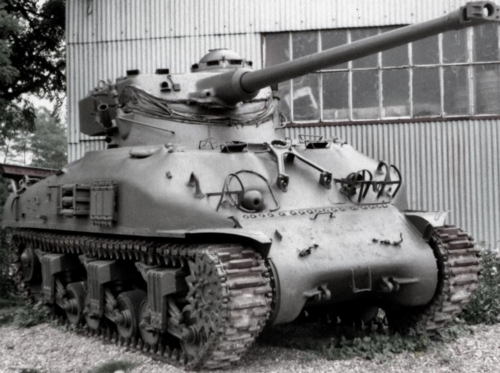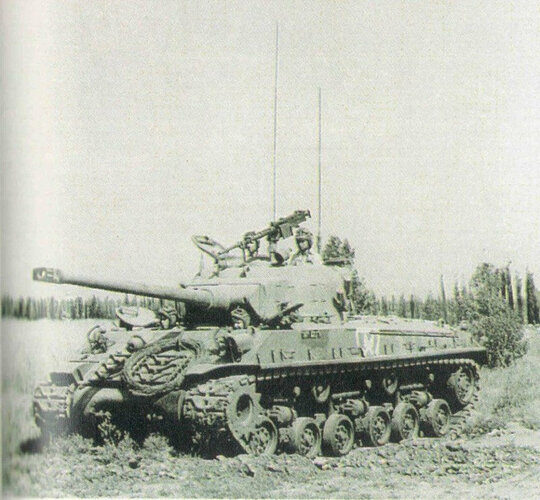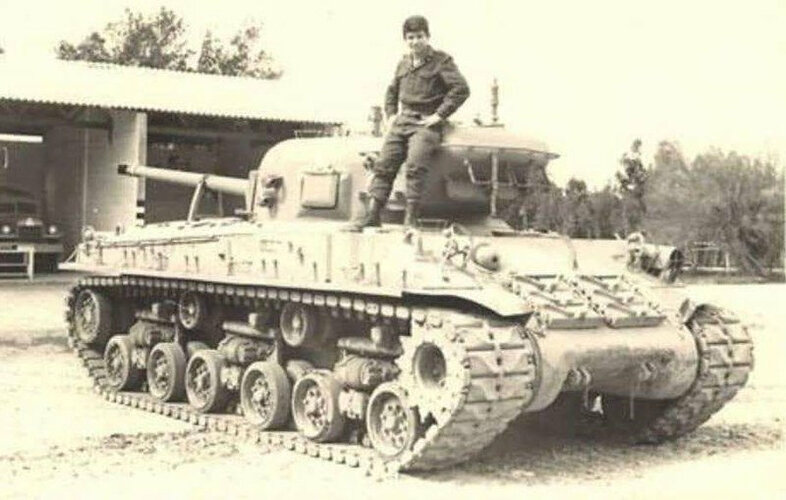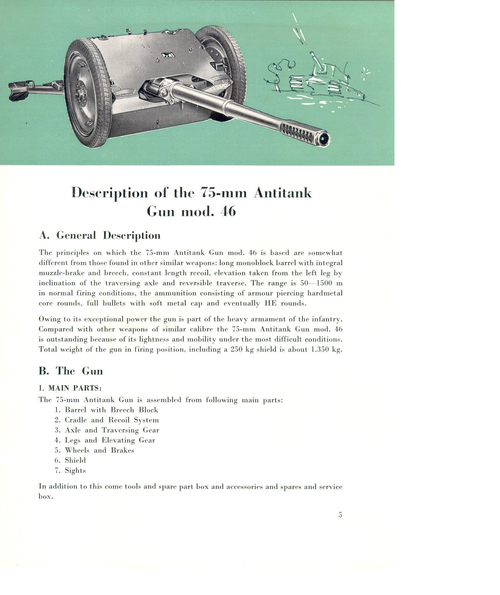I ran across this website that I frustratingly can't find anymore it gave info on the various attempts to up gun the sherman tank and also had a little info on a radically redesigned sherman tank that moved its gear box beneath the tank allowing the turret to be set further back and reducing the height of the vehicle by a foot and matching the t-34 tank 60 degree frontal armored slope but it seems to have disappeared from the internet does anyone have any info on this unbuilt tank
You are using an out of date browser. It may not display this or other websites correctly.
You should upgrade or use an alternative browser.
You should upgrade or use an alternative browser.
Late War M4 Sherman Redesign
- Thread starter danwild6
- Start date
- Joined
- 11 March 2012
- Messages
- 3,122
- Reaction score
- 2,962
There was plenty of talk about up-gunning the Sherman during WW2, but senior officials preferred to invest in the next generation of T-26 heavy tanks with 90 mm guns. Eventually American industry produced such huge numbers of Shermans that they over-whelmed German industry and could still spare hundreds of Shermans for British and Soviet Allies.
As "the Chieftain"(www.youtube.com and World of Tanks) says, Shermans were perfect for their role circa 1940. Unfortunately, Germany continued building larger and larger tanks with longer guns and thicker armour, so that M4 Sherman was out-dated by 1943 or the summer of 1944.
The stock 75 mm gun was fine for infantry support, destroying dug-in troops and small bunkers and soft targets (e.g. trucks). Mind you, most Shermans carried 3/4 high explosive ammunition and only a handful of anti-tank rounds.
Some Shermans were converted to assault tanks by installing 105 mm howitzers for reducing concrete fortifications.
US Army doctrine said that Shermans were primarily supposed to support infantry and leave enemy armour to specialized tank-destroyer regiments. Unfortunately, the enemy has a vote and too many times Shermans found them selves facing Panthers and Tigers. Big German cats also seriously out-ranged Shermans by hundreds or thousands of yards (up to a kilometre), meaning that big cats could usually kill Shermans as soon as they saw them, but Shermans had to close to a few hundred yards before they could kill cats and often only by shooting at thinner armour on cats' tails.
There were a couple of attempts at up-gunning Shermans. The US Army installed longer-barrel 76 mm guns that were slightly better at tank-killing, but still struggled to penetrate Tigers. A prototype 76 mm gun was longer, but they cut off a yard (1 metre) to ease transportation. Removing that yard seriously slowed muzzle velocity, which decreased penetration.
The most successful Sherman up-gun was the Sherman Firefly modification which installed a British high-velocity 17-pounder anti-tank gun. The 17-pounder was one of the few WALLIED AT guns that could consistently penetrate German cats. It's primary advantage was faster muzzle velocity. Since they only perfected HE ammo for 17-pounders near the end of the war, most British and Canadian tank troops comprised 3 Shermans with 75 mm guns plus a Firefly.
As "the Chieftain"(www.youtube.com and World of Tanks) says, Shermans were perfect for their role circa 1940. Unfortunately, Germany continued building larger and larger tanks with longer guns and thicker armour, so that M4 Sherman was out-dated by 1943 or the summer of 1944.
The stock 75 mm gun was fine for infantry support, destroying dug-in troops and small bunkers and soft targets (e.g. trucks). Mind you, most Shermans carried 3/4 high explosive ammunition and only a handful of anti-tank rounds.
Some Shermans were converted to assault tanks by installing 105 mm howitzers for reducing concrete fortifications.
US Army doctrine said that Shermans were primarily supposed to support infantry and leave enemy armour to specialized tank-destroyer regiments. Unfortunately, the enemy has a vote and too many times Shermans found them selves facing Panthers and Tigers. Big German cats also seriously out-ranged Shermans by hundreds or thousands of yards (up to a kilometre), meaning that big cats could usually kill Shermans as soon as they saw them, but Shermans had to close to a few hundred yards before they could kill cats and often only by shooting at thinner armour on cats' tails.
There were a couple of attempts at up-gunning Shermans. The US Army installed longer-barrel 76 mm guns that were slightly better at tank-killing, but still struggled to penetrate Tigers. A prototype 76 mm gun was longer, but they cut off a yard (1 metre) to ease transportation. Removing that yard seriously slowed muzzle velocity, which decreased penetration.
The most successful Sherman up-gun was the Sherman Firefly modification which installed a British high-velocity 17-pounder anti-tank gun. The 17-pounder was one of the few WALLIED AT guns that could consistently penetrate German cats. It's primary advantage was faster muzzle velocity. Since they only perfected HE ammo for 17-pounders near the end of the war, most British and Canadian tank troops comprised 3 Shermans with 75 mm guns plus a Firefly.
jstar
ACCESS: Secret
- Joined
- 12 October 2007
- Messages
- 333
- Reaction score
- 381
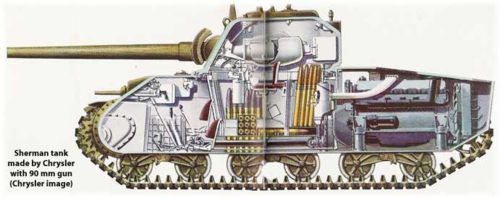
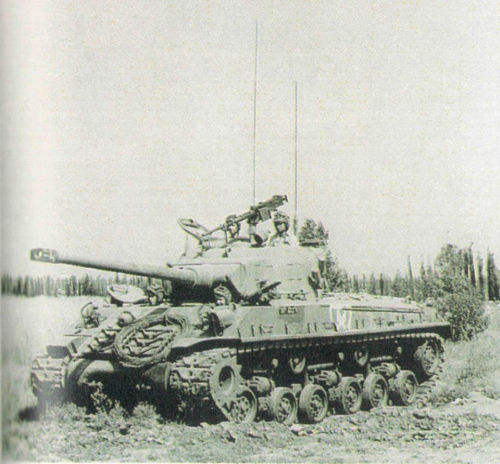
Armorama :: Circumcised Sherman
Armorama.com is the largest online community of Armor/AFV modelers on the Internet.
www.armorama.com
- Joined
- 11 March 2012
- Messages
- 3,122
- Reaction score
- 2,962
The radically-redesigned Sherman you are referring to is the T-20, -22 and -23 series of experimental tanks built during WW2.
The biggest single difference was moving the transmission to the rear of the hull (ala. Russian T-34). A slightly-modified M4 transmission failed early in the test program, so they experimented with hydraulic and electric transmissions, but never got one to run consistently. Removing the long drive-shaft allowed them to reduce height by a couple of feet.
They also slanted glacis plates (hull top front).
Some versions had suspensions resembling the horizontal or vertical volutes (springs) on production Shermans and at least one was tested with torsion bars. They were tested with 75 mm, 76 mm and 3 inch guns.
The program was cancelled after too many transmission problems, but the T23 turret survived on the Sherman M4A2E8 with 76 mm gun.
The biggest single difference was moving the transmission to the rear of the hull (ala. Russian T-34). A slightly-modified M4 transmission failed early in the test program, so they experimented with hydraulic and electric transmissions, but never got one to run consistently. Removing the long drive-shaft allowed them to reduce height by a couple of feet.
They also slanted glacis plates (hull top front).
Some versions had suspensions resembling the horizontal or vertical volutes (springs) on production Shermans and at least one was tested with torsion bars. They were tested with 75 mm, 76 mm and 3 inch guns.
The program was cancelled after too many transmission problems, but the T23 turret survived on the Sherman M4A2E8 with 76 mm gun.
Colonial-Marine
UAVs are now friend, drones are the real enemy.
- Joined
- 5 October 2009
- Messages
- 1,378
- Reaction score
- 1,136
There was also the T25 and T26 which were armed with a 90mm gun. Ultimately the T26E3 with torsion bar suspension was adopted as the M26 Pershing.
The T22E3 and T20E3 (both used torsion bar suspension) were earlier recommended for adoption as the M27 and M27B1 respectively but this went nowhere.
The T22E3 and T20E3 (both used torsion bar suspension) were earlier recommended for adoption as the M27 and M27B1 respectively but this went nowhere.
- Joined
- 19 July 2016
- Messages
- 4,001
- Reaction score
- 3,050
It would be interesting to find out more about that shorter Sherman.
- Joined
- 11 March 2012
- Messages
- 3,122
- Reaction score
- 2,962
Sherman’s were as tall as Tiger 1s because of their engines.
The American M-3 Lee/Grant and M-4 Sherman series of medium tanks were designed around Wright R-975, 9-cylinder, radial, Air-cooled aircraft engines. The bulk of R-975s destined for AFVs were built by Continental Motors. R-975 produced about 300 horsepower with a respectable power-to-weight ratio, moderate fuel consumption, great reliability, but the disadvantage was its 45” diameter. The engine diameter required a deep hull. The other problem was that the drive shaft exited from the middle of the engine, roughly 2 feet above the hull bottom. This forced the turret basket a couple of feet higher. Tankers stowed 75 mm shells vertically below the turret, but it still made Sherman a tall target.
Later Sherman variants were driven by a variety of inline engines, but they retained the original deep hull.
The end-of-War M-18 Hellcat tank-destroyer used a bell housing with the same engine and most of the same drive train components but a drive shaft that was so low that it almost lay on the hull floor. This allowed Hellcats to be a couple of feet shallower than Shermans.
“Bell housing” is a slang term for the propeller speed reduction unit (full of planetary gears) installed on most aircraft engines to reduce crankshaft speed to speeds better suited to propellers.
The American M-3 Lee/Grant and M-4 Sherman series of medium tanks were designed around Wright R-975, 9-cylinder, radial, Air-cooled aircraft engines. The bulk of R-975s destined for AFVs were built by Continental Motors. R-975 produced about 300 horsepower with a respectable power-to-weight ratio, moderate fuel consumption, great reliability, but the disadvantage was its 45” diameter. The engine diameter required a deep hull. The other problem was that the drive shaft exited from the middle of the engine, roughly 2 feet above the hull bottom. This forced the turret basket a couple of feet higher. Tankers stowed 75 mm shells vertically below the turret, but it still made Sherman a tall target.
Later Sherman variants were driven by a variety of inline engines, but they retained the original deep hull.
The end-of-War M-18 Hellcat tank-destroyer used a bell housing with the same engine and most of the same drive train components but a drive shaft that was so low that it almost lay on the hull floor. This allowed Hellcats to be a couple of feet shallower than Shermans.
“Bell housing” is a slang term for the propeller speed reduction unit (full of planetary gears) installed on most aircraft engines to reduce crankshaft speed to speeds better suited to propellers.
Last edited:
- Joined
- 25 January 2020
- Messages
- 1,202
- Reaction score
- 1,746
There was the M50 Super Sherman and the M4A6 which were Sherman "upgrades", or am I missing the point?
- Joined
- 25 January 2020
- Messages
- 1,202
- Reaction score
- 1,746
- Joined
- 11 March 2012
- Messages
- 3,122
- Reaction score
- 2,962
The engine had to be upright because of lubrication problems but they could have adopted either multiple inline engines coupled together or a converter drive system to lower the drive shaft.
I disagree.
A common problem with airplane radial engines is too much oil pooling in the lower cylinders. If you try to start a cold radial engine, you risk hydraulic lock, bent piston rods, etc. That is why bush pilots typically hand pull their radial engines through a dozen blades before starting.
Early Sikorsky helicopters were powered by radial engines installed vertically or tilted at 45 degrees (S-55 and S-58). You might need to re-route a few oil drain lines, but the conversion to horizontal configuration would be easy to do on the oil system.
- Joined
- 19 July 2016
- Messages
- 4,001
- Reaction score
- 3,050
Something I do wonder about, given the Meteor adaptation of the Merlin and all the Packard Merlins, why no like use in US tanks of the time?
- Joined
- 11 March 2012
- Messages
- 3,122
- Reaction score
- 2,962
Yes jstar,
The Shermans’ deep hull did allow fitting a wide variety of engines during WW2, but some of those engines were adopted - in desperation - to plug gaps in production.
Consider that the US Army immediately dumped all their Chrysler Multi-bank powered Sherman on allies at the end of WW2.
The US Army already knew that multi-bank engines would be difficult to maintain after a few years on the road.
The Shermans’ deep hull did allow fitting a wide variety of engines during WW2, but some of those engines were adopted - in desperation - to plug gaps in production.
Consider that the US Army immediately dumped all their Chrysler Multi-bank powered Sherman on allies at the end of WW2.
The US Army already knew that multi-bank engines would be difficult to maintain after a few years on the road.
- Joined
- 11 March 2012
- Messages
- 3,122
- Reaction score
- 2,962
Dear Foo Fighter,
During WW2 Rolls Royce and Packard production of Merlin engines were prioritized towards front-line airplanes (e.g. P-51 Mustang and Lancaster bomber). Centurions really only got Merlin/Meteor engines post-war. Meteor engines were built in a completely different factory.
Meteors were difficult to maintain.
Consider that Israel, etc. Started installing diesels in their Centurians during the 1960s. Meanwhile, Canadian (Meteor-powered) Centurians were left to rust out.
During WW2 Rolls Royce and Packard production of Merlin engines were prioritized towards front-line airplanes (e.g. P-51 Mustang and Lancaster bomber). Centurions really only got Merlin/Meteor engines post-war. Meteor engines were built in a completely different factory.
Meteors were difficult to maintain.
Consider that Israel, etc. Started installing diesels in their Centurians during the 1960s. Meanwhile, Canadian (Meteor-powered) Centurians were left to rust out.
- Joined
- 26 January 2011
- Messages
- 2,228
- Reaction score
- 601
Dear Foo Fighter,
During WW2 Rolls Royce and Packard production of Merlin engines were prioritized towards front-line airplanes (e.g. P-51 Mustang and Lancaster bomber). Centurions really only got Merlin/Meteor engines post-war. Meteor engines were built in a completely different factory.
Meteors were difficult to maintain.
Consider that Israel, etc. Started installing diesels in their Centurians during the 1960s. Meanwhile, Canadian (Meteor-powered) Centurians were left to rust out.
Ah, but the Australians and other European armies used their Meteor engined Centurions until they were replaced by something (usually Leopards). There was nothing wrong with the Meteor which couldn't be fixed with proper maintenance. Australia even took their Centurions to war in South Vietnam successfully.
- Joined
- 9 October 2009
- Messages
- 21,147
- Reaction score
- 12,249
Yes jstar,
The Shermans’ deep hull did allow fitting a wide variety of engines during WW2, but some of those engines were adopted - in desperation - to plug gaps in production.
Consider that the US Army immediately dumped all their Chrysler Multi-bank powered Sherman on allies at the end of WW2.
The US Army already knew that multi-bank engines would be difficult to maintain after a few years on the road.
It was the M4A4 version that had the Chrysler multi-bank engine. Production ceased in Nov 1943 after 7499 units when the number of factories and models was being rationalised. It became the single most used version by the British forces with an eventual 7168 being delivered under Lend-Lease. Some 1610 were remanufactured after use by the US Army for training purposes in the USA for delivery to Britain in 1944. Another 274 went to France in 1943 under Lend-Lease. Despite American dislike of that particular engine British units didn't seem to have a problem with it. The secret was proper maintenance.
Almost 50k Shermans were built in WW2 of which nearly 35% were delivered for use by Britain and another 10% for use by other countries under Lend-Lease.
All you will ever want to know about Shermans (except perhaps the Firefly, certain aspects of the history of which is still not completely clear despite some very detailed research) can be found here. A rivet counters delight!
SleeperService2
Not sure about changing it now.
- Joined
- 16 August 2016
- Messages
- 70
- Reaction score
- 97
Assuming that the Wright was mounted horizontally would the need for a 90deg gear housing reduce the height by that much? I can see the lower prop shaft line would have allowed the forward hull roof to be dropped and, presumably, the revised engine compartment would have allowed for greater fuel storage. If the T-14 was being developed for the British then a similar power train would work well there too.The engine had to be upright because of lubrication problems but they could have adopted either multiple inline engines coupled together or a converter drive system to lower the drive shaft.
I disagree.
A common problem with airplane radial engines is too much oil pooling in the lower cylinders. If you try to start a cold radial engine, you risk hydraulic lock, bent piston rods, etc. That is why bush pilots typically hand pull their radial engines through a dozen blades before starting.
Early Sikorsky helicopters were powered by radial engines installed vertically or tilted at 45 degrees (S-55 and S-58). You might need to re-route a few oil drain lines, but the conversion to horizontal configuration would be easy to do on the oil system.
I accept that it would mean engines destined for aircraft and AFVs would have to be different but surely that was already the case.
monochromelody
ACCESS: Confidential
- Joined
- 3 November 2015
- Messages
- 71
- Reaction score
- 194
Merlin engine is an aircraft engine and production is conducted by Ministry of Aircraft Production, aka MAP. Meteor engine is a tank engine and production is conducted by Ministry of Supply, aka MOS. Basically Meteor wasn't in full scale production until 1944 when Meadows joined the production. Quite a few of those early Cromwells were converted through Liberty engine Centaurs.Dear Foo Fighter,
During WW2 Rolls Royce and Packard production of Merlin engines were prioritized towards front-line airplanes (e.g. P-51 Mustang and Lancaster bomber). Centurions really only got Merlin/Meteor engines post-war. Meteor engines were built in a completely different factory.
Meteors were difficult to maintain.
Consider that Israel, etc. Started installing diesels in their Centurians during the 1960s. Meanwhile, Canadian (Meteor-powered) Centurians were left to rust out.
SleeperService2
Not sure about changing it now.
- Joined
- 16 August 2016
- Messages
- 70
- Reaction score
- 97
Err...not quiteMerlin engine is an aircraft engine and production is conducted by Ministry of Aircraft Production, aka MAP. Meteor engine is a tank engine and production is conducted by Ministry of Supply, aka MOS. Basically Meteor wasn't in full scale production until 1944 when Meadows joined the production. Quite a few of those early Cromwells were converted through Liberty engine Centaurs.Dear Foo Fighter,
During WW2 Rolls Royce and Packard production of Merlin engines were prioritized towards front-line airplanes (e.g. P-51 Mustang and Lancaster bomber). Centurions really only got Merlin/Meteor engines post-war. Meteor engines were built in a completely different factory.
Meteors were difficult to maintain.
Consider that Israel, etc. Started installing diesels in their Centurians during the 1960s. Meanwhile, Canadian (Meteor-powered) Centurians were left to rust out.
There were two Parent Groups one each for Centaur (Liberty) and Cromwell (Meteor) production. Some Centaurs were built with all the features of Cromwells except AFAIK the plate on the lower rear hull for the gearbox adjustment linkage access, and the external track adjuster set-up. Despite extensive research Dick Harley and David Fletcher have found no evidence of Centaurs converted to Cromwell spec. As with the Churchill Mk.IX and XI designations were designated but never implimented.
With reference to the Rolls Royce Publication 'The Rolls-Royce Meteor': The main bottleneck for the Meteor was the crankshaft, at one stage 2000 Merlins were transferred to Rover to be stripped for common parts. Meadows were given the Meteor MK.1A contract in Jul 1943 followed by Rover in Oct 1943 (Mk.III). By the end-Feb 1944 Meadows had delivered 1490 engines. In May 1944 Morris Motors made the first engine while Meadows achieved 80 engines per week. By D-Day 2500 Cromwells were prepared for service.
Throughout the Meteor production was supported by Nottingham based factories at Bobbers Mill who took damaged/ time expired Merlin engines and stripped them for components. Those that weren't up to Merlin standard were checked for Meteor use and used. Later part of the nearby Players factory was set-up to build Meteor engines on site. With the initial contract for 3000 engines complete in Oct 1944 Meadows left the Meteor story.
The production total is less than many expect because it was only used on the Cromwell and then Comet during WW2. Neither were produced on a vast scale.
Over the years I've met and talked to a lot of REME guys. The Meteor demanded a high standard of work but was a good engine. As with the multi-bank engine in the M4A4 British fitters were able to master the maintenance and provide the tank crew with a very reliable engine. Comments by those same fitters about the Liberty are unprintable.
- Joined
- 19 July 2016
- Messages
- 4,001
- Reaction score
- 3,050
Considering the Meteor went all the way through to include the Centurion and Conqueror it cannot be a bad engine. When I first started on Chieftain we had Cent ARV's and never heard of a single complaint. I always wondered just what it could have done in Chieftain.
1635yankee
Recovering aeronautical engineer
- Joined
- 18 August 2020
- Messages
- 478
- Reaction score
- 608
Something I do wonder about, given the Meteor adaptation of the Merlin and all the Packard Merlins, why no like use in US tanks of the time?
There was the Ford GAA engine, which was a derivative of a V-12 aircraft engine that was never produced. Later, the V-12 was resurrected as the GAC engine.
The M4 Sherman was something of a victim of its own success: it was reliable and, early on, more than good enough, however, by 1943 it should have been seen as nearing the end of its usefulness, and the USArmy should have had something better on hand for Normandy. A, those retrospect-o-scopes make fools of us all.
- Joined
- 19 July 2016
- Messages
- 4,001
- Reaction score
- 3,050
I believe that in the early designs of Chieftan the Meteor was considered for it. Wasn't the 40 ton Centurion fitted with it?
The Meteorite was, a V8 turbocharged variety of the original perhaps this was the engine considered.

Rolls-Royce Meteorite - Wikipedia
jstar
ACCESS: Secret
- Joined
- 12 October 2007
- Messages
- 333
- Reaction score
- 381
Something I do wonder about, given the Meteor adaptation of the Merlin and all the Packard Merlins, why no like use in US tanks of the time?
- The GAA was used in the M4A3 (1,690), M4A3(75)W (3,071), M4A3(76)W (1,400), M4A3 (105) (500), M4A3E2 (254), M4A3(76)W HVSS (3,142), M4A3(105) HVSS (2,539), M10A1 (1,413), and M7B1 (826).
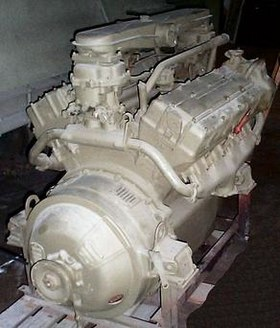
- Joined
- 19 July 2016
- Messages
- 4,001
- Reaction score
- 3,050
Thanks for that, much appreciated.
SleeperService2
Not sure about changing it now.
- Joined
- 16 August 2016
- Messages
- 70
- Reaction score
- 97
I believe that in the early designs of Chieftan the Meteor was considered for it. Wasn't the 40 ton Centurion fitted with it?
It certainly was JohnR four Meteorite applications listed;
Meteorite 2 Vickers FV300
RMD100 Marine Launches
202B FV4202 (40-ton Centurion) Note: Only ten of this version were built
204 Mighty Antar Transporter
I don't know about the Meteor & Chieftain connection but I know a man who will certainly have the information. Might be a couple of days though...
That's a first got him on the first attempt. No the Meteor was never considered seriously for Chieftain. It was decided early on that the engine was to be multi-fuel and the Meteor couldn't manage that so may have made it onto a sketch or to but no serious work was done on it.
Last edited:
- Joined
- 21 May 2006
- Messages
- 2,833
- Reaction score
- 1,917
Just read:
"In 1953, Finland designed for Israel a version of the Sherman armed with a 75 mm cannon of Finnish production, but the project was not accepted by Israeli engineers."
(Source: https://tanks-encyclopedia.com/coldwar/Israel/M50-51_Super-Sherman.php)
Anyone got anything on this Finnish/Israeli program?
Regards
Pioneer
"In 1953, Finland designed for Israel a version of the Sherman armed with a 75 mm cannon of Finnish production, but the project was not accepted by Israeli engineers."
(Source: https://tanks-encyclopedia.com/coldwar/Israel/M50-51_Super-Sherman.php)
Anyone got anything on this Finnish/Israeli program?
Regards
Pioneer
- Joined
- 28 November 2006
- Messages
- 703
- Reaction score
- 694
Here you have a cut-out from a brochure on the 75mm Finnish anti-tank gun, a drawings of the gun's mounting in the Sherman's turret plus a photo of the gun. It was designated as 75 K/44 and used German ammunition for the Pak 40 anti-tank gun, i.e. 75x715R.Just read:
"In 1953, Finland designed for Israel a version of the Sherman armed with a 75 mm cannon of Finnish production, but the project was not accepted by Israeli engineers."
(Source: https://tanks-encyclopedia.com/coldwar/Israel/M50-51_Super-Sherman.php)
Anyone got anything on this Finnish/Israeli program?
Regards
Pioneer
Piotr
Attachments
- Joined
- 21 May 2006
- Messages
- 2,833
- Reaction score
- 1,917
Thank you PiotrHere you have a cut-out from a brochure on the 75mm Finnish anti-tank gun, a drawings of the gun's mounting in the Sherman's turret plus a photo of the gun. It was designated as 75 K/44 and used German ammunition for the Pak 40 anti-tank gun, i.e. 75x715R.Just read:
"In 1953, Finland designed for Israel a version of the Sherman armed with a 75 mm cannon of Finnish production, but the project was not accepted by Israeli engineers."
(Source: https://tanks-encyclopedia.com/coldwar/Israel/M50-51_Super-Sherman.php)
Anyone got anything on this Finnish/Israeli program?
Regards
Pioneer
Piotr
Regards
Pioneer
I ran across this website that I frustratingly can't find anymore it gave info on the various attempts to up gun the sherman tank and also had a little info on a radically redesigned sherman tank that moved its gear box beneath the tank allowing the turret to be set further back and reducing the height of the vehicle by a foot and matching the t-34 tank 60 degree frontal armored slope but it seems to have disappeared from the internet does anyone have any info on this unbuilt tank
The "Persherman" was a Chrysler proposal to continue production of Sherman chassis's, but with 90mm turrets from the T26 project.
The turret ring diameters were the same, and the turret drives and controls were compatible. If the M26 had been adopted as the preferred armored division tank, adoption of the Persherman as the preferred infantry support tank would have had ammo logistics advantages. Turret installations could have been done in Europe, saving on shipping capacity as long as the existing tank chassis supply was sufficient. And, of course the 90mm gun with a few rounds of HVAP per tank would finally have given the infantry tanks a sufficient AT capability, eliminating the inefficient need for separate tank destroyers and for specially gunned tanks.
Attachments
My Dear Danwild6, you may be confusing the dates on an early "improved" sherman design.I ran across this website that I frustratingly can't find anymore it gave info on the various attempts to up gun the sherman tank and also had a little info on a radically redesigned sherman tank that moved its gear box beneath the tank allowing the turret to be set further back and reducing the height of the vehicle by a foot and matching the t-34 tank 60 degree frontal armored slope but it seems to have disappeared from the internet does anyone have any info on this unbuilt tank

APG’s 'Improved M4' - Tank Encyclopedia
The M4 is one of the most famous tanks in the world, but even as the first model was rolling off the assembly line, plans were afoot to improve it.
 tanks-encyclopedia.com
tanks-encyclopedia.com
Essentially, just as the M4 was entering production; they put out RFPs for an improved version; getting replies back from Aberdeen Proving Ground and Detroit Tank Arsenal with two different "improved" M4s.
Honestly, I believe now that I think about it; if Pearl Harbor hadn't happened; the M4 Medium would have been quickly superceded by the M5 Medium sometime in 1942. But with Pearl Harbor in December 1941; we needed lots of tanks and we needed them NOW...similar to how T-34 improvement projects died in the USSR.
Elan Vital
ACCESS: Secret
- Joined
- 6 September 2019
- Messages
- 283
- Reaction score
- 573
If I recall though, studies on alternative engines to meet demand were already ongoing in 1941 pre-PH plans already called for substantial army extension. To say nothing about the fact the US and Germany were virtually at war in the Atlantic already and a declaration of war in 1942 was likely, before either Sherman rework program could enter production. Still sad they didn't exploit the substantial hull rework of the large hatch Shermans in late 1943 to implement deeper structural changes like the Detroit Arsenal proposal.My Dear Danwild6, you may be confusing the dates on an early "improved" sherman design.I ran across this website that I frustratingly can't find anymore it gave info on the various attempts to up gun the sherman tank and also had a little info on a radically redesigned sherman tank that moved its gear box beneath the tank allowing the turret to be set further back and reducing the height of the vehicle by a foot and matching the t-34 tank 60 degree frontal armored slope but it seems to have disappeared from the internet does anyone have any info on this unbuilt tank

APG’s 'Improved M4' - Tank Encyclopedia
The M4 is one of the most famous tanks in the world, but even as the first model was rolling off the assembly line, plans were afoot to improve it.tanks-encyclopedia.com
Essentially, just as the M4 was entering production; they put out RFPs for an improved version; getting replies back from Aberdeen Proving Ground and Detroit Tank Arsenal with two different "improved" M4s.
Honestly, I believe now that I think about it; if Pearl Harbor hadn't happened; the M4 Medium would have been quickly superceded by the M5 Medium sometime in 1942. But with Pearl Harbor in December 1941; we needed lots of tanks and we needed them NOW...similar to how T-34 improvement projects died in the USSR.
- Joined
- 21 May 2006
- Messages
- 2,833
- Reaction score
- 1,917
I stumbled across this if it helps any danwild6
I found the CDA M4 Sherman bolt-on armour wooden mockup/study interesting....
Regards
Pioneer
I found the CDA M4 Sherman bolt-on armour wooden mockup/study interesting....
Regards
Pioneer
To elaborate further on the time pressures facing Sherman production...you have to remember that from 30 June 1941 to 6 December 1941, the plan was for an ultimate 27 division army, to be:
9 x Corps HQs and Corps Troops
18 x Infantry Divisions (National Guard)
8 x Infantry Divisions (Regular Army)
1 x Infantry Division (Motorized, Regular Army)
2 x Cavalry Divisions + 1 Cavalry Brigade
4 x Armored Divisions
Four armored divisions with 1941 organization (2 light tk regts, 1 med tk regt / 265 light tanks and 161 medums) gives you a total of 1,060 light tanks and 644 mediums to equip your force.
Add in another division's worth of tanks for training and schools, and you still only need 1,325 lights and 805 mediums. That's possible to meet with a small tank force -- The US Armored Force knew that the hull mount design for the M3 Medium was obsolete and they suggested that production of the M3 Medium be limited to a small number (360 was bandied about), pending completion of the 75mm gun turret design.
BUT, the British needed lots of tanks for the Western Desert; so mass production of the M3 was ordered right away, and any chances of an actual M4 "Improved" went to zero right after Pearl Harbor, because the US Army now had to look seriously at having to build:
60~ Armored Divisions = 9,660 Medium Tanks
70~ Tank Battalions (Medium) = 3,570 Medium Tanks
To equip the Victory Plan, before Marshall did the "90 Division Gamble", in addition to supplying the UK and USSR with tanks...
9 x Corps HQs and Corps Troops
18 x Infantry Divisions (National Guard)
8 x Infantry Divisions (Regular Army)
1 x Infantry Division (Motorized, Regular Army)
2 x Cavalry Divisions + 1 Cavalry Brigade
4 x Armored Divisions
Four armored divisions with 1941 organization (2 light tk regts, 1 med tk regt / 265 light tanks and 161 medums) gives you a total of 1,060 light tanks and 644 mediums to equip your force.
Add in another division's worth of tanks for training and schools, and you still only need 1,325 lights and 805 mediums. That's possible to meet with a small tank force -- The US Armored Force knew that the hull mount design for the M3 Medium was obsolete and they suggested that production of the M3 Medium be limited to a small number (360 was bandied about), pending completion of the 75mm gun turret design.
BUT, the British needed lots of tanks for the Western Desert; so mass production of the M3 was ordered right away, and any chances of an actual M4 "Improved" went to zero right after Pearl Harbor, because the US Army now had to look seriously at having to build:
60~ Armored Divisions = 9,660 Medium Tanks
70~ Tank Battalions (Medium) = 3,570 Medium Tanks
To equip the Victory Plan, before Marshall did the "90 Division Gamble", in addition to supplying the UK and USSR with tanks...
So maybe an end-of-war infantry division tank with the 650hp engine in a suitably lengthened and maximally lowered Jumbo hull, with the Spicer or GM automatic transmission, and advanced suspension with wide tracks, and the T26 turret with 90mm gun...?
Similar threads
-
-
-
General Steel Castings Corporation Tank Designs (circa 1941)
- Started by Pelzig
- Replies: 6
-
-

